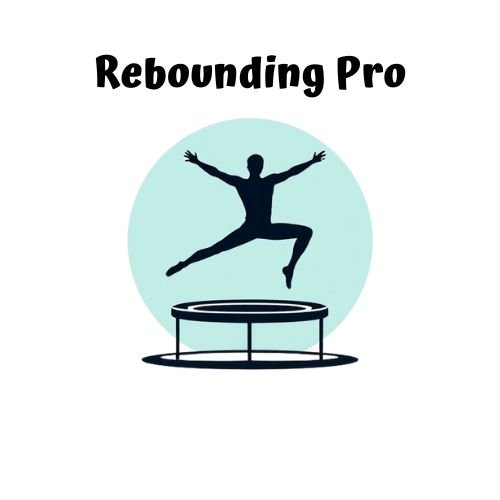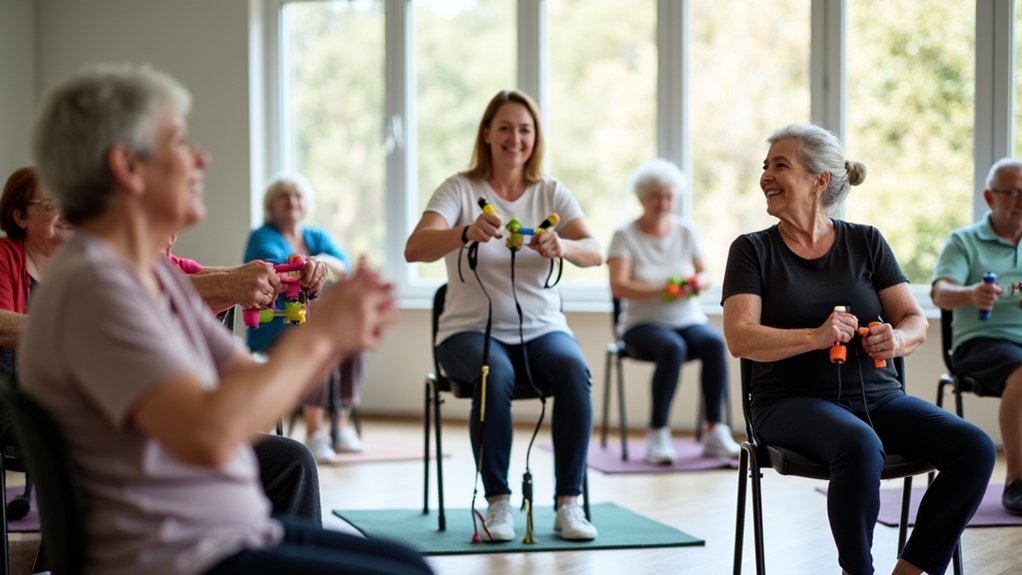Your lymphatic system needs movement to effectively flush toxins and reduce stress. Try gentle rebounding for 10 minutes daily, rhythmic breathing while bouncing, figure-eight arm movements, ankle pumps, core engagement exercises, full-body rebounding sequences with jumping jacks, and mindful cooldown stretches. These techniques stimulate lymph flow, release tension, and strengthen your immune response. Consistent practice of these accessible movements will transform both your physical wellness and stress resilience.
Gentle Rebounding: The Foundation of Lymphatic Movement

While many exercise regimens focus on cardio or strength, gentle rebounding stands as the cornerstone of effective lymphatic health management. This simple up-and-down motion on a mini trampoline creates the ideal conditions to move lymph through your body’s natural waste removal system.
You’ll appreciate that rebounding is joint-friendly yet powerfully effective at stimulating lymphatic drainage. Just 10 minutes of varied movements engages multiple muscle groups while flushing toxins and reducing swelling. For those with lymphedema, it’s particularly beneficial.
Gentle bouncing offers maximum lymphatic benefits with minimal impact, making it ideal for wellness at any fitness level.
The beauty of rebounding lies in its accessibility—regardless of your fitness level, you can improve your lymphatic health through consistent practice.
As you bounce gently, you’re simultaneously strengthening your immune system and promoting overall wellness through enhanced lymphatic circulation.
Rhythmic Breathing While Bouncing for Stress Release
As you establish your rebounding routine, integrating rhythmic breathing patterns can transform a simple exercise into a powerful stress-relief practice.
Coordinating your breath with each gentle bounce activates your parasympathetic nervous system, creating a natural relaxation response while enhancing lymphatic movement.
When combining deep breathing with your rebounding session:
- Feel tension melt away as oxygen floods your system with each synchronized breath
- Experience the calming centeredness as your mind focuses solely on the rhythmic breathing pattern
- Notice the lightness in your body as lymphatic circulation improves, releasing built-up toxins
- Embrace the meditative quality that emerges when movement and breath work in harmony
This mindful approach turns a physical activity into a complete mind-body stress management technique.
Arm Circulation Patterns on the Rebounder

When performing figure-eight arm movements on your rebounder, you’ll enhance lymphatic flow while massaging the axillary lymph nodes beneath your arms.
Alternating punch sequences can further stimulate upper body circulation, creating a pumping action that helps move stagnant fluid through congested areas.
Try incorporating gentle windmill rotations into your routine to expand the chest cavity and encourage deeper lymphatic drainage throughout your shoulders and torso.
Figure-Eight Arm Movements
Because they engage multiple muscle groups simultaneously, figure-eight arm movements represent one of the most effective lymphatic exercises you can perform on a rebounder.
While maintaining a gentle bounce, trace a figure-eight pattern with your arms to stimulate lymph flow throughout your upper body and reduce swelling in areas prone to fluid retention.
This coordinated movement enhances your lymphatic system’s natural drainage while providing a low-impact workout suitable for any fitness level.
The rhythmic motion creates a powerful effect on your overall wellbeing:
- Dramatically improves circulation to arms and shoulders
- Naturally relieves stress and tension in your upper body
- Enhances coordination and balance with each fluid movement
- Reduces lymphedema symptoms through consistent practice
You’ll notice both physical and emotional benefits as you incorporate this technique regularly.
Alternating Punch Sequences
The alternating punch sequence provides a dynamic approach to lymphatic drainage while you bounce on your rebounder.
As you punch forward with alternating arms, you’re creating rhythmic arm movements that stimulate lymph fluid movement throughout your upper body.
This low-impact exercise is particularly beneficial if you’re managing lymphedema, as it doesn’t strain affected areas while still promoting circulation.
The punching motion engages your shoulders, chest, and arms, working to support lymphatic flow in these regions.
You’ll notice improved coordination and balance as you develop this technique, which enhances your overall stability.
Aim for just a few minutes of alternating punches during each session to reduce stress and boost your mood through endorphin release, while simultaneously strengthening your cardiovascular and immune systems.
Gentle Windmill Rotations
Gentle windmill rotations represent an elegant solution for enhancing lymphatic circulation while you bounce gently on your rebounder.
This mindful movement helps stimulate lymph flow while strengthening your shoulders and arms without jarring your joints.
As you perform these circular arm patterns, listen to your body and adjust the speed to maintain comfort.
The rhythmic motion creates a meditative effect while supporting your lymphatic health.
Try these variations to maximize benefits:
- Forward circles – Feel the tension melt away as your shoulders release
- Backward rotations – Experience the joy of increased mobility
- Alternating arm patterns – Celebrate the balanced energy flowing through your body
- Slow, deliberate movements – Embrace the calming sensation of mindful circulation
Lower Body Techniques to Stimulate Lymph Flow

Lower body techniques are essential for boosting your lymphatic circulation, with rebounding offering excellent drainage benefits through its gentle bouncing motion.
Try ankle pump exercises while sitting or lying down to activate the calf muscle pump that pushes lymph upward against gravity.
You’ll also benefit from alternating leg stretches, such as hamstring flossing and leg marches, which create the muscle contractions needed to move lymphatic fluid efficiently through your system.
Rebounding For Drainage Benefits
While many exercise routines focus on building muscle or burning calories, rebounding on a mini-trampoline offers unique benefits for your lymphatic system.
Just 10 minutes of gentle bouncing can greatly enhance lymphatic flow throughout your body while being gentle on your joints—perfect if you’re managing lymphedema or seeking improved overall health.
- Feel immediate relief as the rhythmic up-and-down movement stimulates your lymphatic vessels, enhancing natural detoxification.
- Experience joint-friendly exercise that’s accessible regardless of your fitness level.
- Watch swelling decrease when you incorporate specific movements like weight shifts and jumping jacks.
- Enjoy the process as you simultaneously improve your balance and coordination.
The consistent, gentle bouncing motion of rebounding creates the ideal environment for best lymphatic movement throughout your system, making it an invaluable addition to your self-care routine.
Ankle Pump Exercises
As you sit at your desk or relax on your couch, your lymphatic system could be benefiting from simple ankle movements that take almost no effort. Ankle pumps stimulate lymphatic flow by engaging your calf muscles, which act as natural pumps pushing fluid back toward your heart.
Try incorporating 10-15 repetitions of controlled ankle pumps into your daily routine. You’ll gradually improve both circulation and muscle strength while reducing swelling.
| Position | Technique | Benefits |
|---|---|---|
| Seated | Point toes up, then down | Easy integration into workday |
| Lying | Flex and extend fully | Maximum range of motion |
| Standing | Rise onto toes, lower heels | Added weight resistance |
| Combined | Pair with leg raises | Enhanced lymphatic drainage |
These exercises are particularly valuable if you have limited mobility, as they’re effective whether performed sitting or lying down.
Alternating Leg Stretches
Building on the ankle pump exercises, alternating leg stretches offer another powerful method to activate your lymphatic system. This technique supports ideal lymph nodes function while reducing lower extremity swelling.
Most Physical Therapists recommend combining these stretches with deep breathing to enhance their effectiveness.
To maximize lymphatic health benefits:
- Lie on your back with one leg extended and the other bent, switching positions every 10-15 seconds.
- Elevate your legs slightly above heart level to utilize gravity’s natural drainage assistance.
- Synchronize your breathing—inhale as you extend, exhale as you switch positions.
- Perform for 5-10 minutes daily, especially if you’re experiencing lymphatic congestion.
Core Engagement Exercises for Central Lymphatic Support
Several core engagement exercises serve as powerful catalysts for lymphatic circulation in your body’s central region. By keeping your core engaged during trunk rotations and leg circles, you’ll stimulate abdominal lymph nodes while enhancing overall lymphatic flow.
This activation is especially beneficial for those with various health conditions that affect fluid retention.
Bridge exercises strengthen your glutes and facilitate pelvic tilt, which helps drain lymph from your lower extremities. When performing ankle pumps and hamstring flossing, maintain a flat back to maximize lymphatic stimulation.
Energize your lymphatic system through proper bridge positioning—your glutes and back alignment create the perfect drainage pathway for lower body fluid.
These movements create a muscle pump action that effectively moves lymph through your system.
For best results, practice these exercises consistently, even while wearing compression garments. You’ll likely notice reduced leg swelling and improved lymphatic function as your core becomes stronger and more efficient at supporting central lymphatic health.
Full-Body Rebounding Sequences for Maximum Drainage
When you step onto a rebounder, you’re activating one of the most effective tools for thorough lymphatic drainage. This gentle bouncing movement stimulates lymphatic fluid flow throughout your entire system, enhancing detoxification and immune function with just 10 minutes of daily practice.
To maximize your rebounding benefits, try these simple sequences:
- Weight shift jumps to target specific lymphatic pathways
- Jumping jacks for full-body lymphatic activation
- Gentle bouncing with deep breathing to reduce stress while moving lymph
- Alternating high and low bounces to create pressure changes that pump lymph efficiently
The rebounder’s buoyancy reduces joint impact, making it ideal even for those with mobility challenges.
Always consult your healthcare provider before starting full-body rebounding sequences, especially if you’re managing lymphedema.
Mindful Cooldown Movements for Lymphatic Balance
After an invigorating rebounding session, your lymphatic system needs gentle guidance to continue its cleansing work. Incorporating mindful cooldown movements helps optimize lymphatic drainage while reducing exercise-induced stress.
Begin with controlled movements like leg circles and ankle pumps to encourage lymph fluid circulation throughout your body. Focus on core engagement during these gentle stretches to maintain proper spinal alignment, which supports healthy lymphatic function.
Deep belly breathing stimulates your abdominal lymph nodes, enhancing overall fluid movement. As you exhale, visualize tension releasing while your lymphatic system processes waste more efficiently.
Consistency is key—make these cooldown techniques part of your regular routine to manage lymphedema and promote long-term wellness.
Your body’s fluid balance will improve with each mindful practice, creating lasting benefits for your lymphatic health.
Frequently Asked Questions
What Is the Best Movement for Lymphatic Drainage?
Walking is your best option for lymphatic drainage. You’ll benefit from its rhythmic motion for just 20-30 minutes daily. Don’t overlook aquatic therapy and yoga, which also effectively stimulate lymph flow.
Does Movement Help the Lymphatic System?
Yes, movement absolutely helps your lymphatic system. When you exercise, muscle contractions pump lymph fluid through your body, reducing swelling, improving circulation, and enhancing immune function. Even gentle activities like walking make a significant difference.
How Do I Get My Lymphatic System Moving?
You’ll get your lymphatic system moving by walking daily, trying gentle rebounding, and practicing leg exercises like ankle pumps. Don’t forget to elevate your legs regularly and consult a healthcare professional for personalized guidance.
Does Jumping Help With Lymphatic Drainage?
Yes, jumping definitely helps with lymphatic drainage. When you bounce, you’re creating pressure changes that pump lymph fluid through your system. It’s one of the most effective ways to stimulate your lymphatic flow.
In Summary
You’ve now discovered seven powerful ways to support your lymphatic system through mindful movement. When you’re feeling stressed, remember that your body’s drainage system needs gentle activation. Just a few minutes on the rebounder each day will help you release tension, clear toxins, and restore balance. Make these simple techniques part of your daily routine, and you’ll notice improved energy, clearer thinking, and a calmer state of being.





Leave a Reply